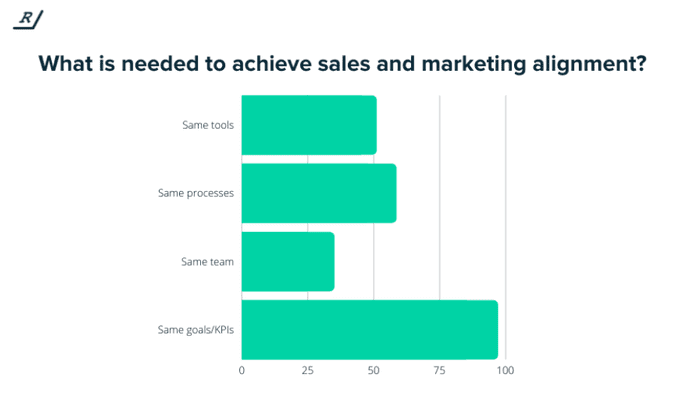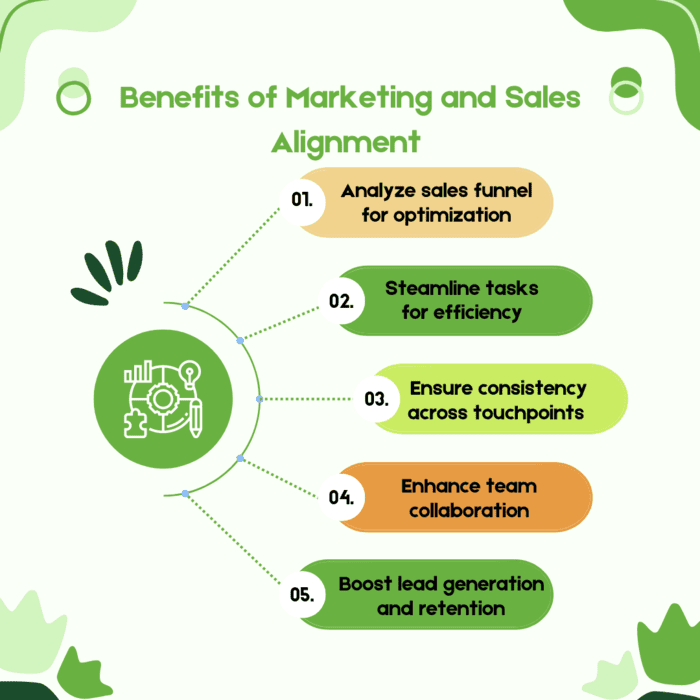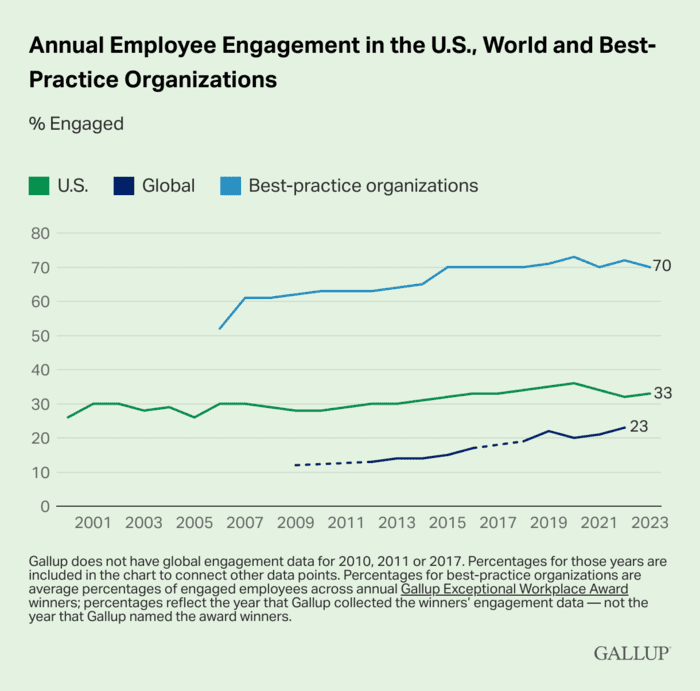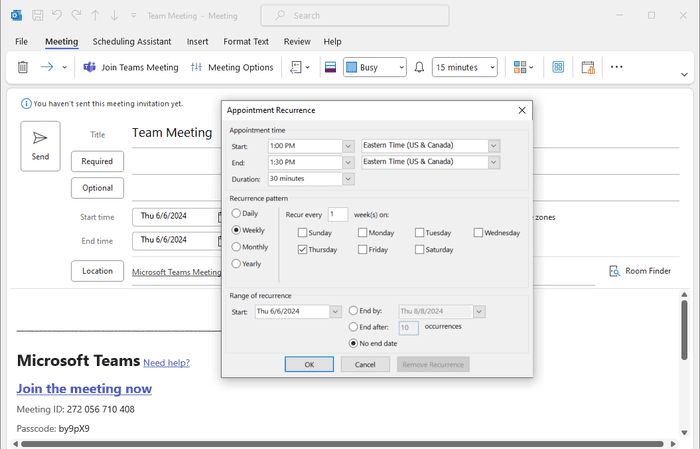Marketing and Sales Alignment Strategies: 4 Proven Tactics to Boost Revenue
Aligning marketing and sales teams can drive over 200% revenue growth, with 38% higher sales win rates and 36% higher customer retention.
This synergy reduces customer acquisition costs and boosts customer lifetime value by 20%. Discover how to effectively align your teams for maximum impact.
The terms “marketing” and “sales” are often used interchangeably but serve two distinct purposes.
Marketing is the arm of the organization that draws the attention. Sales is the function that converts that traffic into customers.
Despite their differences, marketing and sales work hand-in-hand to maximize revenue, streamline results, and acquire new customers.
Yet, the marketing and sales machine rarely runs smoothly. Both teams typically work in silos, largely unaware of what the other team is doing while trying to achieve separate objectives.
Now imagine a business environment where marketing and sales alignment is effortless. Marketing efforts seamlessly feed into sales priorities, and sales teams provide consistent feedback to better inform marketing strategies. This harmonious relationship helps drive business growth and goal accomplishment seamlessly and efficiently.
Make this fantasy your business reality by achieving marketing and sales alignment to converge for the greater good of the organization.
Veer away from disjointed efforts that yield lower sales and move in the direction of a synchronized strategy that boosts the bottom line.
In this article, you’ll walk away with the knowledge to bridge the gap between your sales and marketing teams. We’ll share proven tactics, tools, and techniques to ensure a mutually beneficial partnership between the two teams and know how to direct your cross-department collaboration moving forward.
A few of the tools we will introduce can be found right on UNmiss, so be sure to check out all the free content, SEO, and AI tools we have to offer marketing teams.
Marketing and Sales Alignment 101
The internal workings of a business are complicated. Teams often remain focused on their priorities without visibility into or regard for other teams’ work. This holds true not only for marketing and sales teams but also for other teams across the organization, such as finance, customer support, human resources, and more.
Despite one common overarching goal every team is trying to achieve, business growth, teams often stay in their own lanes rather than integrating operations.
The importance of marketing and sales alignment can’t be understated. It’s a crucial task for every business to take on to ensure these two teams work collaboratively and effectively with each other to reach common goals. Integrating both teams’ work can paint a clearer picture of the common goals and objectives both teams are trying to reach and how their work together achieves these goals.
Through a unified approach toward customer acquisition, conversion, and retention, barriers are broken, and work is viewed at a holistic level. Teams recognize the importance of regular check-ins, improved transparency, and goal sharing.
When marketing and sales teams align, the benefits are far-reaching. By growing together rather than apart, businesses can:
- Learn what’s working and what isn’t, such as where in the sales funnel potential customers are getting stuck and where optimizations can be made.
- Foster better communication to develop a deeper understanding of customer needs and preferences.
- Streamline efforts to create less work for both teams and shift work towards what matters most.
- Offer consistency across every touchpoint.
- Develop better relationships with colleagues in an environment that encourages team building and collaboration.
- Build lead generation efforts and improve customer retention rates.
- Identify opportunities to work better together through open discussions.
Perhaps the biggest benefit of marketing and sales alignment is shared success. A conversion or an up-sell is no longer merely an increase in revenue but a win because of marketing and sales alignment. Victories are celebrated collectively, and achievements are recognized through collaboration.
Data Sharing and Analysis
In a business with myriad departments, operating as individual teams rather than collectively can stifle growth and achievement of organizational goals. Effective and transparent data sharing between departments can mitigate this risk.
For marketing and sales teams specifically, it’s important to share customer data to help uncover insights, buying behavior, purchase patterns, and more. Integrating data through tool sharing can help both teams identify opportunities and bottlenecks.
By openly exchanging customer insights and data sharing, both teams will have a better understanding of their target customer and what motivates them.
The Power of Knowledge Sharing
Marketing teams source customer insights through numerous initiatives such as email marketing, social media, website analysis, keyword research, and more.
Let’s use conducting a website audit for example. UNmiss offers a free website audit tool which provides insights into where user experience may be falling short by identifying the pitfalls that exist within your current site design. Some of these errors may include meta descriptions, headers, content, page speed, and mobile and desktop errors.
By identifying these errors, marketing teams can provide this feedback to sales to share specific areas where potential customers may not be converting due to the obstacles they’re facing.
Using the same example, if a UNmiss website audit reveals a significant number of visitors are abandoning their carts due to slow page speed, marketing should share this information with the sales teams.
Through this knowledge transfer, sales teams will be better equipped to address potential customer concerns related to slow page speeds, enabling them to directly address the concern and offer alternative suggestions for purchase completion until the issue is resolved.
UNmiss Website Audit Tool interface
Sales teams also have a wealth of valuable customer information through direct customer interactions such as phone calls, demos, and email outreach. This information likely lives in a customer relationship management (CRM) software solution, like Salesforce.
When marketing teams have access to CRM software solutions, they’re better able to identify:
- Top performing accounts
- Accounts in the decision-making stage
- Customer accounts with issues
- Up-sell opportunities
- Lead scoring and lead prioritization
- Engagement history
With both teams having access to the same data in your business’ CRM, teams can identify the effectiveness of marketing campaigns and ensure the right accounts are receiving strategic outreach.
Marketing can fine-tune their outreach strategies and campaigns to deliver high-quality leads to sales. Sales can target high-performing accounts and those that are most engaged with the business.
Creating a business environment where data analysis and tools are mutually shared helps drive better business outcomes across the board, from stronger customer relationships to tailored outreach to improve conversions.
Communication Strategies for Alignment
Uniting teams and sharing common goals helps improve productivity, scale efficiency, and maximize performance. Communication is the cornerstone for fostering close-knit team environments which entails maintaining open lines, setting regular meetings, and leveraging technology.
When teams feel comfortable and confident in reaching out to their colleagues whenever an issue or opportunity arises, businesses are poised to achieve operational efficiency. When departments openly communicate, they can share valuable insights, feedback, and other information.
For example, marketing can share an upcoming campaign related to a new product launch and prepare the sales teams with questions they may receive from prospective customers. Sales can also share feedback they’re hearing from customers such as pain points and challenges customers are facing.
For example, customers may not be aware that a certain product feature exists that can significantly improve their work. If sales communicate this common issue to marketing, marketing can, in turn, prioritize creating content around this product feature to boost awareness. This may lead to increased sales and customer adoption.
With a bidirectional flow of information, both teams stay aware and can adjust their strategies for success. It also helps build trust and relationships with colleagues across departments, which may improve job satisfaction.
According to a Gallup employee engagement study, companies that foster teamwork see a 50% reduction in employee churn.
The Importance of Regular Meetings
Regular, recurring meetings are essential to grow the bond between sales and marketing teams. Keeping these meetings scheduled on employees’ calendars ensures they’re prepared and ready to share the high-level projects they’ve been working on. It also allows an open forum to discuss items that impact both teams.
Here are a few ways to keep the information transfer ongoing:
- Weekly Stand-Ups: Establish a recurring weekly meeting for all sales and marketing team members. In this meeting, allow team members to share their top priorities and challenges they’re facing. Leaders should share broader organizational changes, celebrations, or high-priority projects. Keep these meetings around 30 minutes.
- Monthly Meetings: Establish a monthly meeting for all sales and marketing team members that’s longer, such as 60 to 90 minutes. In these meetings share performance metrics, plan campaigns, discuss opportunities, and highlight noteworthy wins. This is also an opportunity to share information and metrics gained through tools, such as the previous website audit example. Managers can share reports or platform screenshots with the wider team.
- Employee Education: Employees can and should constantly be expanding their skill sets for personal and professional growth. Hold periodic workshops, such as every quarter, for teams to learn new skills or get up to speed on new products or features. These workshops can help team members gain a deeper understanding of their colleague’s work while broadening their knowledge.
- Regular Feedback: Employees should feel comfortable and encouraged to communicate with each other whenever a need arises. Whether the preferred communication channel is email or via a team communication platform like Slack, employees should feel assured it’s acceptable to reach out to their colleagues.
- Huddles: Huddles can be scheduled or spontaneous. They’re designed for team members to quickly meet to share pertinent information such as the introduction of a new team member or the departure of an executive.
A regular cadence of scheduled meetings enhances teamwork, ensures departments are working towards mutual goals and enhances transparency around key organizational changes and objectives.
Slack Interface example
Creating Unified Goals and Metrics
When uniting marketing and sales it’s important to identify key performance indicators (KPIs). These metrics may be divergent for both teams, however, there will be overlap and commonality in metrics across both teams to track in tandem.
Some of these metrics may include lead generation, conversion rates, and revenue targets, which further highlight the intersection of both teams. Remember that, irrespective of what role you are in within an organization you all are working towards a shared vision.
Marketing and sales leaders should look to establish common KPIs to create a sense of unity for both teams and improve visibility into key targets to achieve.
Marketing teams often leverage a SMART goal framework which means goals are specific, measurable, achievable, relevant, and time-bound. By using this strategic framework to measure success, leaders can develop quantifiable and clear goals for their teams.
Using the same SMART goal framework across the organization ensures consistency, aligning the method in which both marketing and sales teams view and accomplish their initiatives.
Ensure your SMART goals align with broader business objectives and can be tracked to showcase performance.
Shared Metrics and Dashboards for Improved Transparency
As previously mentioned, relevant team members need to have a transparent view of the different dashboards that reflect performance and customer behavior. Shared dashboards allow for real-time visibility into KPIs to analyze progress being made.
Shared dashboards also allow for cross-functional collaboration by providing a central hub for marketing and sales-related information, enabling teams to better analyze performance.
Rather than waiting for monthly meetings to see consumer patterns and trends, teams can access this invaluable information any time they need it. This level of transparency helps improve decision-making, allows for quick priority pivoting, and can identify bigger issues like a website crash or form fill issue.
With accessible and informative data at a team’s fingertips, data-driven decisions are more accessible, and more strategic decisions can be made. It also helps businesses stay ahead of their competitors whose teams may be operating independently of one another.
The High Cost of Marketing and Sales Misalignment
When marketing teams aren’t in sync with sales, the impact can be both costly and frustrating.
For marketing teams, the consequences of misalignment are clear. 68% of marketers think that sales teams aren’t utilizing marketing content’s full potential, leading to a waste of time and energy.
Consider if a marketing team spends 10 hours drafting a comprehensive e-book with the sole purpose of generating leads for sales, yet the sales team never shares the e-book with their contacts. Or worse, marketing hasn’t effectively communicated to the sales team that this resource exists.
Research has shown that aligning both teams could lead to a staggering 209% increase in revenue from marketing specifically.
For B2B organizations, tightly aligned sales and marketing operations achieve nearly a quarter (24%) faster three-year revenue growth and 27% faster three-year profit growth.
A separate study conducted by Marketo found aligning sales and marketing results in a 108% improvement in lead acceptance.
Finally, according to Aberdeen Group, companies that optimize the marketing/sales connection grow 32% faster, while companies that fail to work on this crucial relationship see their business decline.
The evidence is clear; achieving marketing and sales alignment is necessary to facilitate revenue generation and grow profits. Our hope is the techniques we’ve shared with you today will help guide your path toward a more harmonious relationship between your own sales and marketing teams.
For marketers, UNmiss offers a vast array of free tools to help optimize content, streamline work, and identify areas for improvement. Be sure to take advantage of them to save time and fast-track results.











